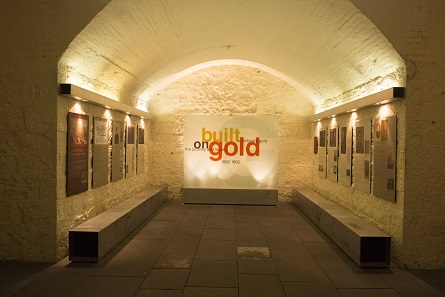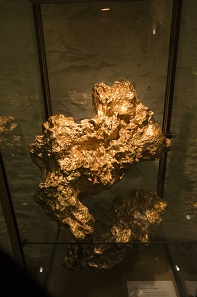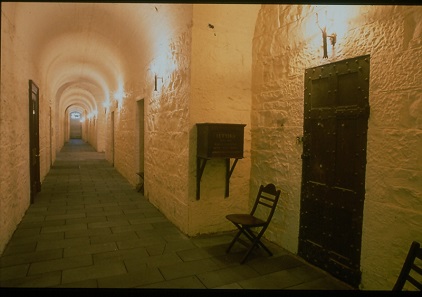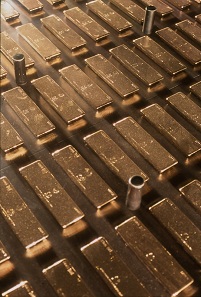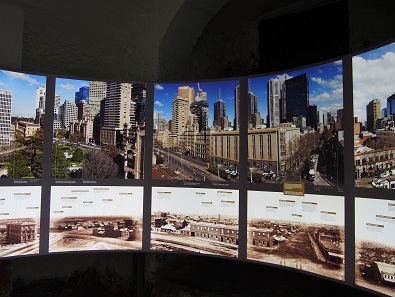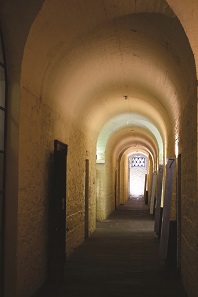May 24, 2018 – The story of the journey of Victorian gold, from the diggings, as it passed through the hands of the gold buyers, escort troopers and on some occasions, bushrangers until it eventually left the colony bound for the northern hemisphere.
A seating area in the vaults of the Old Treasury Building. Photo: Old Treasury Building.
The exhibition describes how Victoria’s new-found riches shaped Melbourne’s future and paid for the many grand public buildings which still grace the city’s streets. The central Victorian goldfields yielded so much gold that Melbourne’s Treasury offices in William Street could not secure the weekly convoys of gold bullion. In 1857 John James Clark, an 18-year-old architectural draftsman, was commissioned to design a new Treasury building to house the precious metal and to serve as Victoria’s principal administrative centre. Eight of the former gold vaults beneath the Old Treasury in Spring Street have been transformed to present Built on Gold.
Replica of the ‘Welcome Stranger’, the largest gold nugget ever found. From June 2018 this replica will feature in a new exhibition ‘Gold Rush: 20 Objects, 20 Stories’ which will run until 26 May, 2019. Photo: Old Treasury Building.
To make a profit from his labour a digger had to exchange his nuggets or gold dust for cheques, paper money or gold sovereigns. Professional gold buyers worked the goldfields, usually operating out of tents or rough sheds. They negotiated a gold price with the hungry and thirsty diggers which was often well below what the banks and bullion merchants in Melbourne and Geelong would pay. The gold buyer would arrange to have large shipments of gold escorted to the city banks where he would turn a profit on his investment. Gold prices varied over the years. By mid-1852, the Melbourne gold price was around £3 per ounce, while on the diggings as low as £2.50 per ounce was accepted. Return on gold exported to the United Kingdom was calculated at £4 an ounce.
The gold vaults of the Old Treasury Building before the installation of the ‘Built on Gold’ exhibition. Photo: Old Treasury Building.
In the early 1850s, if a Ballarat digger chose to increase his profits by selling his gold in the city, he faced a journey of 89km to Geelong or 113km to Melbourne through rough country. He risked attack by bushrangers at every turn, and the longer he was on the road, the less time he had to dig for gold. In October 1851, a Government gold escort service began operating from Buninyong to Melbourne, via Geelong, charging one shilling per ounce of gold. The following year a competing escort service was established by a group of Melbourne businessmen. Yet, no matter how well guarded the gold wagons were, there were always men bold enough to brandish a pistol and bail-up the escort.
Gold bars as displayed in the Old Treasury Building. Photo: Old Treasury Building.
Shipping played a vital role in the economy and scale of the Victorian gold rushes, by transporting a vast number of gold-seeking immigrants and trade goods to the colony and carrying Victoria’s precious metal to the European banks. Very fast clipper ships evolved to meet a growing demand for faster travel. Magnificent sailing vessels like the famous Marco Polo of the Black Ball Line or the Phoenician of the White Star Line, competed to make the journey from England to Melbourne in under two and a half months. For the first time, travellers could personally attend to business in Australia and in Europe within six months. The Victorian gold rushes prompted one of the largest voluntary mass-migrations in history. People from England, Europe, China and America – mostly men – swamped Victoria’s ports. In December 1851, Victoria’s population was 97,489. By Christmas the following year it had increased to 168,321 people.
With a shortage of housing in Melbourne, many new arrivals were forced to camp in a tent city. Increased traffic began to wear away at the colony’s roads. Basic services like water supply and garbage and sewerage collection were pushed to the limit, resulting in a very real threat to the population’s health. However, business opportunities abounded for the thrifty and imaginative. Many people became richer from servicing the needs of gold rush Melbourne, than by digging for the precious metal itself.
The Melbourne Panorama shows a young 37-year-old Melbourne with the same cityscape 150 years later. Taken from the roof of Parliament House, Charles Nettleton’s 1862 panorama shows a quiet city, with houses amongst beautiful gold rush architecture. Photo: Old Treasury Building.
In less than a decade the gold rushes transformed Melbourne from a rambling colonial service town to a metropolis with the confidence of a modern city. From 1853 to 1854 the number of buildings in Melbourne doubled. In mid-1853 Antonio Gabrielli, a visiting businessman, raised a loan of £500,000 for the Melbourne Corporation to upgrade the City’s rutted and muddy streets. By the middle of the decade gas pipelines had been laid in the city centre, a railway linked Melbourne with the coast and an electric telegraph communicated with Williamstown, Geelong and Adelaide. Talented young British architects like John James Clark, Peter Kerr and William Wilkinson Wardell, were drawn to Melbourne by the building boom, and created grand public buildings
As Melbourne prospered during the gold rush, its cultural life flourished. Internationally renowned performers were drawn to the city by the prospect of large, affluent audiences. The great Shakespearian actor Gustavus Vaughan Brooke presented repeated seasons. Sopranos Anna Bishop and Catherine Hayes performed popular arias, and virtuoso violinist Miska Hauser dazzled audiences with his lightening technique. The Irish dancer and courtesan Lola Montes created a sensation with her risqué Spider Dance.
The politically forward thinking people of early Melbourne campaigned for many rights we now expect, including the 8-hour movement: 8 hours work, 8 hours leisure, 8 hours sleep. Photo: Old Treasury Building.
Sport became another popular leisure activity. Melbourne Cricket Ground opened as a commercial venture in 1856 and by Christmas 1861 the first touring English cricket side thrilled Melbourne crowds. The colony’s working people also developed a greater political awareness. Led by Melbourne’s influential stonemasons, the city’s building industry achieved an acceptance of the eight hour working day in 1856.
Exactly how much gold was stored in the Old Treasury’s gold vaults is not known. By the late 1860s annual gold discoveries were greatly reduced as the gold rushes lost momentum. Large companies financed deep lead-mining and quartz mining and the day of the ‘lucky digger’, who panned and sluiced for nuggets, was over. Instead, Old Treasury’s gold vaults were used to store public service files and registers that recorded the statistics of the now prosperous colony of Victoria.
The corridor of the gold vaults after the installation of the ‘Built on Gold’ exhibition. Photo: Old Treasury Building.
Victorian gold provided the money and credit to stimulate trade and industrialization in Britain, Europe and North America. Investors in the northern hemisphere viewed Victoria, with its burgeoning population, as a very active market for consumer and luxury goods and with a seemingly inexhaustible source of raw materials like wool, wheat, minerals and meat. British technology, particularly in the areas of heavy industry, railways and communications, aided Victoria’s need for rapid development, as the colony’s population expanded at an unprecedented rate.
This link takes you to the Old Treasury Building Museum.
This video shows a contemporary documentation on the Victoria Gold Rush.
More on Australia’s golden past in this article.




